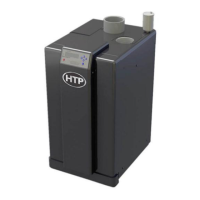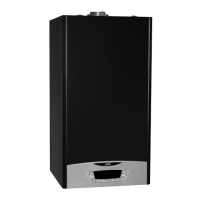LP-387 Rev. 011 Rel. 005 Date 1.3.19
12
K. Removing a Boiler from a Common Vent System
Failure to follow all instructions can result in ue gas spillage and
carbon monoxide emissions, causing severe personal injury or death.
Do not install the boiler into a common vent with any other
appliance. This will cause ue gas spillage or appliance malfunction,
resulting in possible substantial property damage, severe personal
injury, or death.
When removing an existing boiler, follow the steps below.
1. Seal any unused openings in the common venting system.
2. Visually inspect the venting system for proper size and horizontal
pitch to determine if there is blockage, leakage, corrosion, or other
deciencies that could cause an unsafe condition.
3. If practical, close all building doors, windows, and doors between the
space in which the boiler remains connected to the common venting
system and other spaces in the building. Turn on clothes dryers and
any appliances not connected to the common venting system. Turn
on any exhaust fans, such as range hoods and bathroom exhausts,
at maximum speed. Do not operate a summer exhaust fan. Close all
replace dampers.
4. Place in operation the appliance being inspected. Follow the lighting
instructions. Adjust the thermostat so the appliance will operate
continuously.
5. Test for spillage at the draft hood relief opening after 5 minutes of
main burner operation. Use the ame of a match or candle or smoke
from a cigarette.
6. After it has been determined that each appliance remaining
connected to the common venting system properly vents when tested
as outlined, return doors, windows, exhaust fans, replace dampers,
and any other gas burning appliances to their previous condition of
use.
7. Any improper operation of the common venting system should
be corrected to conform to the National Fuel Gas Code, ANSI Z223.1.
When resizing any portion of the common venting system, the
system should approach the minimum size as determined using the
appropriate tables in Appendix G of ANSI Z223.1.
NOTE: DAMAGE TO THE BOILER CAUSED BY EXPOSURE TO
CORROSIVE VAPORS IS NOT COVERED BY WARRANTY. (Refer to
the limited warranty for complete terms and conditions.)
Products to Avoid
Areas Likely to Have
Contaminants
Spray cans containing
uorocarbons
Dry cleaning / laundry areas
and establishments
Permanent wave solutions Swimming pools
Chlorinated waxes / cleaners Metal fabrication plants
Chlorine-based swimming pool
chemicals
Beauty shops
Calcium chloride used for thaw-
ing
Refrigeration repair shops
Sodium chloride used for water
softening
Photo processing plants
Refrigerant leaks Auto body shops
Paint or varnish removers Plastic manufacturing plants
Hydrochloric or Muriatic acid
Furniture renishing areas and
establishments
Cements and glues New building construction
Antistatic fabric softeners used
in clothes dryers
Remodeling areas
Chlorine-type bleaches, laundry
detergents, and cleaning
solvents
Garages and workshops
Adhesives used to fasten
building products
Table 2 - Products and Areas Likely to Have Contaminants
Figure 5 - CO Warning Label
L. Water Chemistry Requirements*
Chemical imbalance of the water supply may aect eciency
and cause severe damage to the appliance and associated
equipment. It is important that the water chemistry on both the
domestic hot water and central heating sides are checked before
installing the appliance. Water quality must be professionally
analyzed to determine whether it is necessary to treat the water.
Various solutions are available to adjust water quality. Adverse
water quality will aect the reliability of the system. In addition,
operating temperatures above 135
o
F will accelerate the build-up
of lime scale and possibly shorten appliance service life. Failure of
an appliance due to lime scale build-up, low pH, or other chemical
imbalance IS NOT covered by the warranty.
Closed loop water must be free of corrosive chemicals, sand, dirt,
and other contaminates. It is up to the installer to ensure the water
does not contain corrosive chemicals or elements that can damage
the heat exchanger.
If you suspect that your water is contaminated in any way,
discontinue use of the appliance and contact an authorized
technician or licensed professional.
• Water pH between 6.5 and 8.5
• pH levels below 6.5 can cause an increase in the rate of
corrosion. pH of 8.5 or higher can potentially cause lime
scale build-up
• Maintain water pH between 6.5 and 8.5. Check with litmus
paper or have it chemically analyzed by a local water
treatment company.
• If the pH is not between 6.5 and 8.5, consult a local water
treatment company for solutions.

